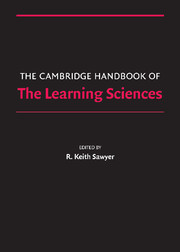Book contents
- Frontmatter
- Contents
- Preface
- Contributors
- 1 Introduction
- PART I FOUNDATIONS
- PART II METHODOLOGIES
- PART III THE NATURE OF KNOWLEDGE
- PART IV MAKING KNOWLEDGE VISIBLE
- PART V LEARNING TOGETHER
- PART VI LEARNING ENVIRONMENTS
- 28 Motivation and Cognitive Engagement in Learning Environments
- 29 Learning as a Cultural Process
- 30 Prospects for Transforming Schools with Technology- Supported Assessment
- 31 Internet Use in Schools
- 32 Teacher Learning Research and the Learning Sciences
- 33 Scaling Up
- 34 Conclusion
- Afterword: After How Comes What
- Epilogue: The Fundamental Issue in the Learning Sciences
- Author Index
- Subject Index
- References
34 - Conclusion
The Schools of the Future
Published online by Cambridge University Press: 05 June 2012
- Frontmatter
- Contents
- Preface
- Contributors
- 1 Introduction
- PART I FOUNDATIONS
- PART II METHODOLOGIES
- PART III THE NATURE OF KNOWLEDGE
- PART IV MAKING KNOWLEDGE VISIBLE
- PART V LEARNING TOGETHER
- PART VI LEARNING ENVIRONMENTS
- 28 Motivation and Cognitive Engagement in Learning Environments
- 29 Learning as a Cultural Process
- 30 Prospects for Transforming Schools with Technology- Supported Assessment
- 31 Internet Use in Schools
- 32 Teacher Learning Research and the Learning Sciences
- 33 Scaling Up
- 34 Conclusion
- Afterword: After How Comes What
- Epilogue: The Fundamental Issue in the Learning Sciences
- Author Index
- Subject Index
- References
Summary
The schools of today were largely designed in the nineteenth and twentieth centuries to provide workers for the industrial economy. In the 1970s, economists and other social scientists began to realize that the world's economies were shifting from an industrial economy to a knowledge economy (Bell, 1973; Drucker, 1993; Toffler, 1980). By the 1990s, educators had begun to realize that if the economy was no longer the 1920s-era factory economy, then our schools were designed for a quickly vanishing world (Bereiter, 2002; Hargreaves, 2003; Sawyer, in press). Leading thinkers in business, politics, and education are now in consensus that schools have to be redesigned for the new economy, and that the learning sciences are pointing the way to this new kind of school – a school that teaches the deep knowledge required in a knowledge society. This consensus led major governmental and international bodies to commission reports summarizing learning sciences research; these reports include the U.S. National Research Council's How People Learn (Bransford, Brown, & Cocking, 2000), the OECD's Innovation in the Knowledge Economy: Implications for Education and Learning (2004), and a study of twenty-eight countries conducted by the International Society for Technology in Education, called Technology, Innovation, and Educational Change: A Global Perspective (Kozma, 2003).
- Type
- Chapter
- Information
- The Cambridge Handbook of the Learning Sciences , pp. 567 - 580Publisher: Cambridge University PressPrint publication year: 2005
References
- 2
- Cited by



